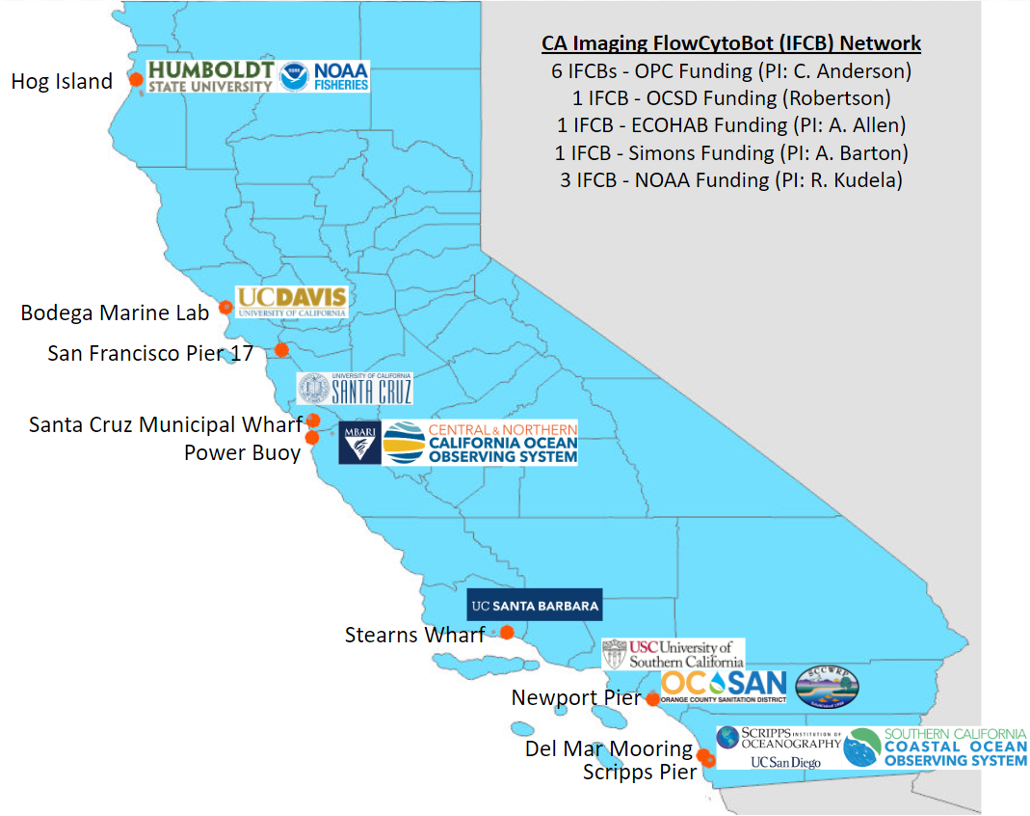This week, dense phytoplankton blooms (commonly called ‘red tides’) are becoming more visible throughout the beaches of Southern California. Three pier-based monitoring sites for Harmful Algal Blooms (HABs) show a dramatic increase in bloom-producing phytoplankton that are discoloring the water from olive green to dark red or orange. HAB monitoring efforts that traditionally sample once per week are being augmented with a new network of automated imaging systems (called IFCBs) that allow researchers to continuously monitor the microscopic communities in our coastal waters. The quantity and type of plankton species in the ocean can cause drastic changes to the color of the water and may cause harm to marine life or ecosystems. While these blooms are generally harmless to humans, it may cause a rash or increased chance for ear and sinus infections when swimming, or mild respiratory symptoms from being in contact or near the water when bloom conditions arise. If however, you experience respiratory symptoms after being exposed to the bloom please complete this short 12-question survey.
We don’t know exactly how long these blooms will last but will provide weekly updates as feasible. For more information on blooms and our monitoring efforts go to: https://sccoos.org/harmful-algal-bloom and subscribe to CA HAB Bulletin listserv to receive the monthly CA HAB Bulletin.
Here’s the latest from our SCCOOS monitoring sites:
1. Stearns Wharf - April 27, 2022
An Akashiwo sanguinea bloom is also occurring at the Santa Barbara station alongside another mucus-producing species, Cochlodinium polykrikoides. Both species can be harmful to fish and marine life if concentrations of these cells are high enough. We are monitoring these blooms closely and informing wildlife rescue centers of these blooms.
2. Newport Beach Pier - April 25, 2022
Monday the water was bright orange-red and the dominant plankton was Akashiwo sanguinea. This species of plankton produces a slimy surfactant that may cause harm to birds, fish, or bivalves if the bloom is dense enough. As of Wednesday, the bloom is showing signs of decreasing at this station.
3. La Jolla Scripps Pier - April 27, 2022
A very visible red tide moved onshore and spread throughout La Jolla. The species responsible for the dark red water is Lingulodinium polyedra (L. poly). This is the species known to bloom frequently here and produces bioluminescence at night. This bloom has been waxing and waning over the last few weeks and appears to have finally set in.
To view the latest phytoplankton data at one of the nine coastal stations in near real-time visit the California Imaging FlowCytobots Network (CA IFCB Network) dashboard. Work is underway to develop automated image classification.

A map of the CA IFCB Network for an automated early warning system for Harmful Algal Bloom events in California. Funded by the California Ocean Protection Council and significantly leverages federal funding and observing infrastructure already in place at many of our coastal observing stations.
